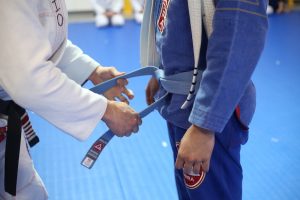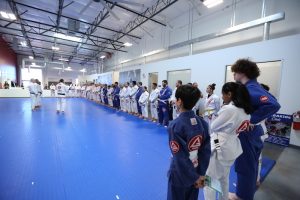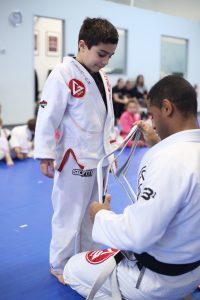GB Student question: “How long does it take to get your blue belt?”
A really common question when most new students start training Jiu-Jitsu is “How long does it take to get your blue belt?”

ㅤ
While this is an honest question for a goal-oriented person to ask when getting into a martial art, it is not that easy to answer.
ㅤ
The simple answer might be commonly anywhere from 1 year to 2 years from the start of your training. But read on to see why this is not a set rule.
ㅤ
There is no set time period or a specific list of techniques that a student tests to get their blue belt in the Gracie Barra school.
ㅤ
The decision to award a blue belt is up to the discretion of the instructor who takes several factors into consideration:
1 Regular class attendance. You simply can’t graduate to the next stripe or belt if you are not in class and learning the curriculum that the instructor is teaching everyone. Some students show up the week before GB school promotions and photo day hoping for a promotion. But as one GB professor remarked with a grin “Oh, I know who has been here and who has not.”
ㅤ
Training consistency is the:
1 factor in determining the level that you will reach in your Jiu-Jitsu. Students with great potential come and go in every academy. The cliche “A black belt is a white belt who never quit” is true. You just need to keep showing up over the long haul.

ㅤ
2 Natural ability and or previous experience. A new student who comes into the Fundamentals class with years of wrestling experience or who already has a black belt in judo will obviously progress much faster than a complete “newb”. Some individuals are very physically talented and seem to watch a movie once then are able to execute the move flawlessly immediately afterward! Most of us are not so blessed with natural athletic ability and need to drill a lot before the move becomes one we can use. Both the experienced grappler and the natural athlete will progress at a faster rate than the average.
ㅤ
It can be negative to compare oneself with another student. “Why did they get another stripe when we both started at the same time?” the disappointed student asks. The truth is we all have different attributes and strengths and weaknesses and can not all devote an equal amount of energy and time to training. Famed basketball coach John Wooden said that we should not compare ourselves to others but to measure ourselves by how close we were to maximize our own potential.
“Never try to be better than someone else. Learn from others, and try to be the best you can be. Success is the by-product of that preparation.” John Wooden

ㅤ
3 Time training. While there are prodigies who we hear about who took to Jiu-Jitsu like a duck to water, trained full time and received their black belt in 4 years, this is simply not the reality for the majority of Jiu-Jitsu mortals. Most black belts have been on the mats for more than 10 years. Jiu-Jitsu requires a long term investment of time to accumulate the skills and knowledge to be a legitimate black belt.
ㅤ
In fact, the IBJJF has time guidelines for belt promotion that stipulate minimum time that should be spent at a belt level before graduation to the next colored belt.
The graduation of athletes must also meet the following minimum periods of permanence in each color:
Practitioners between 04 to 15 years old – No minimum period of stay in each belt.
Athletes between 16 and 17 years old
White – No minimum time
Blue – No minimum time
Purple – 2 (two) years
Athletes from 18 years old – White Belt to Brown Belt
White – no minimum time
Blue – 2 (two) years
Purple – 1 (one) year and a half
Brown – 1 (one) year
Source: IBJJF General System of Graduation
ㅤ
 An inquiry about when one can expect their blue or purple belt is likely to be answered with a curt “When you are ready” by the instructor, discouraging further discussion. In the Jiu-Jitsu school culture, it is frowned upon for the students to be directly questioning their instructor about when they can expect a belt promotion.
An inquiry about when one can expect their blue or purple belt is likely to be answered with a curt “When you are ready” by the instructor, discouraging further discussion. In the Jiu-Jitsu school culture, it is frowned upon for the students to be directly questioning their instructor about when they can expect a belt promotion.ㅤ
In the Jiu-Jitsu class, students are urged to focus more on applying themselves to attending class consistently and to learning the positions that your instructor is teaching. Don’t get too focused on the next belt. If you show up and apply yourself, the belts will take care of themselves.
ㅤ
See also on Gracie Barra: Stop Getting Tapped Out!
